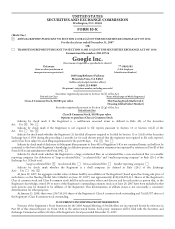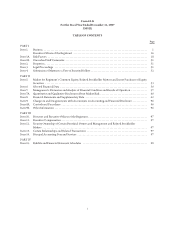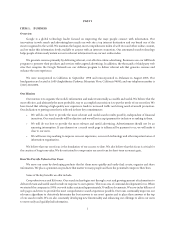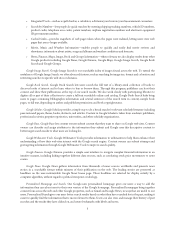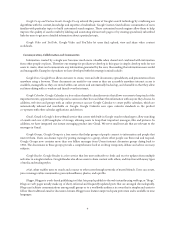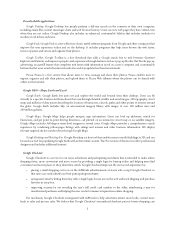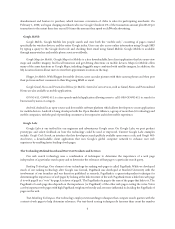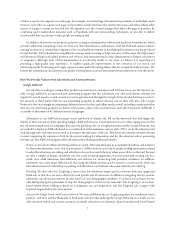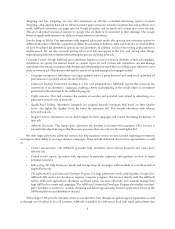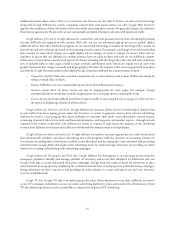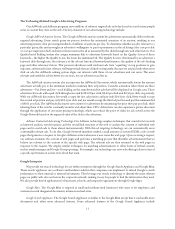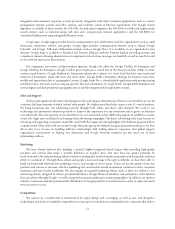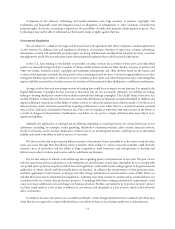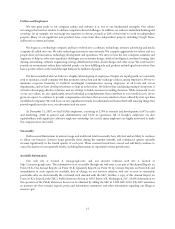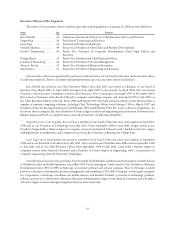Google 2007 Annual Report Download - page 20
Download and view the complete annual report
Please find page 20 of the 2007 Google annual report below. You can navigate through the pages in the report by either clicking on the pages listed below, or by using the keyword search tool below to find specific information within the annual report.abandonment and barriers to purchase, which increases conversion of clicks to sales for participating merchants. On
February 1, 2008, we began charging merchants who use Google Checkout 2% of the transaction amount plus $0.20 per
transaction to the extent these fees exceed 10 times the amount they spend on AdWords advertising.
Google Mobile
Google Mobile. Google Mobile lets people search and view both the “mobile web,” consisting of pages created
specifically for wireless devices, and the entire Google index. Users can also access online information using Google SMS
by typing a query to the Google shortcode and checking their email using Gmail Mobile. Google Mobile is available
through many wireless and mobile phone services worldwide.
Google Maps for Mobile. Google Maps for Mobile is a free downloadable Java client application that lets users view
maps and satellite imagery, find local businesses and get driving directions on mobile devices. Maps for Mobile offers
many of the same functions as Google Maps, including draggable maps combined with satellite imagery. In addition, the
My Location feature allows users to view their approximate location on the map.
Blogger for Mobile. With Blogger for mobile devices, users can take pictures with their camera phones and then post
their pictures and text comments to their blog using MMS or email.
Google Gmail, News and Personalized Home for Mobile. Several of our services, such as Gmail, News and Personalized
Home are also available as mobile applications.
GOOG-411. GOOG-411 is a free speech-enabled application allowing users to call 1-800-GOOG-411 to search for
businesses by name or category.
Android. Android is an open-source and free mobile software platform which allows developers to create applications
for mobile devices. Android is being developed with the Open Handset Alliance, a group of more than 30 technology and
mobile companies, with the goal of providing consumers a less expensive and richer mobile experience.
Google Labs
Google Labs is our testbed for our engineers and adventurous Google users. On Google Labs, we post product
prototypes and solicit feedback on how the technology could be used or improved. Current Google Labs examples
include: Google Code Search, an interface that lets developers search publicly available open-source code, and Google Web
Accelerator, a downloadable client application that uses Google’s global computer network to enhance user web
experience by enabling faster loading of web pages.
The Technology Behind Search and Our User Products and Services
Our web search technology uses a combination of techniques to determine the importance of a web page
independent of a particular search query and to determine the relevance of that page to a particular search query.
Ranking Technology. One element of our technology for ranking web pages is called PageRank. While we developed
much of our ranking technology after Google was formed, PageRank was developed at Stanford University with the
involvement of our founders and was therefore published as research. PageRank is a query-independent technique for
determining the importance of web pages by looking at the link structure of the web. PageRank treats a link from web page
A to web page B as a “vote” by page A in favor of page B. The PageRank of a page is the sum of the pages that link to it. The
PageRank of a web page also depends on the importance (or PageRank) of the other web pages casting the votes. Votes
cast by important web pages with high PageRank weigh more heavily and are more influential in deciding the PageRank of
pages on the web.
Text-Matching Techniques. Our technology employs text-matching techniques that compare search queries with the
content of web pages to help determine relevance. Our text-based scoring techniques do far more than count the number
6



